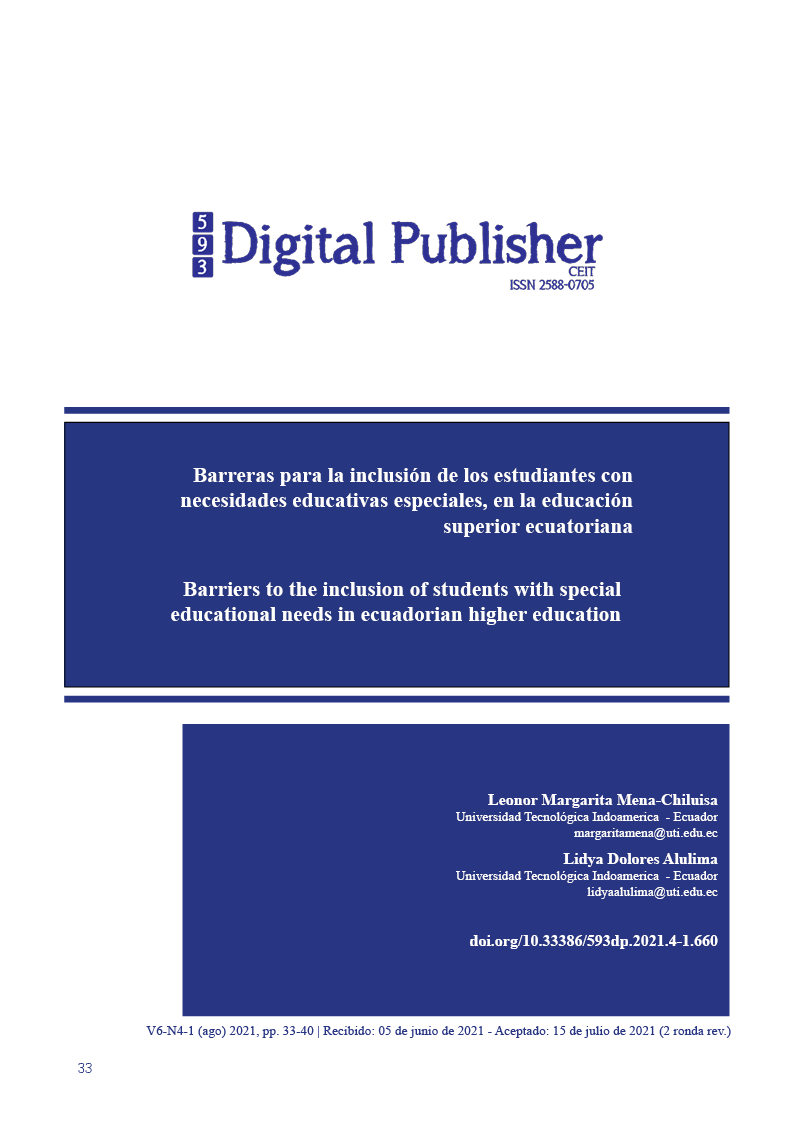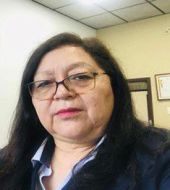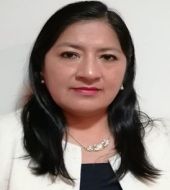Barriers to the inclusion of students with special educational needs in ecuadorian higher education
Main Article Content
Abstract
Inclusive education at a general level has progressed gradually in the last decade, different policies have been disseminated to protect children and adolescents, mainly so that they can access education. In Ecuador, regulations have been issued to promote inclusion in education, however, in the field of higher education there are different barriers that limit the entry, permanence and qualification of students with different characteristics and contexts.
UNESCO (2016) mentions that, for inclusive education, each child must be considered to have their particularities, characteristics and requirements to learn differently, and educational systems must take these characteristics into account and adapt according to their needs; aspects that in the field of Higher Education in Ecuador almost go unnoticed.
In the Regulation to the Organic Law of Higher Education (2010) it is mentioned that higher education is essential to achieve a dignified life, respecting interculturality, diversity and harmonious coexistence in the environment. being necessary that the HEIs implement pertinent mechanisms so that these students acquire competences that allow them to develop in daily life.
Being necessary to carry out a qualitative-quantitative study, with the participation of teachers from different HEIs, which allows verifying the situation of students with SEN in HEIs, considering the General Objective: Determine the barriers to inclusion faced by students with Special Educational Needs in Higher Education. The survey technique was used with the instrument the questionnaire in Google Forms for data collection. The results refer in the first instance the exclusion that students are subject, as well as the limited diffusion of inclusive policies generated in different Legal Regulations, which causes a learning process without differentiation, without curricular adaptations, being preponderant factors for them to abandon their studies. university studies.
Downloads
Article Details

This work is licensed under a Creative Commons Attribution-NonCommercial-ShareAlike 4.0 International License.
1. Derechos de autor
Las obras que se publican en 593 Digital Publisher CEIT están sujetas a los siguientes términos:
1.1. 593 Digital Publisher CEIT, conserva los derechos patrimoniales (copyright) de las obras publicadas, favorece y permite la reutilización de las mismas bajo la licencia Licencia Creative Commons 4.0 de Reconocimiento-NoComercial-CompartirIgual 4.0, por lo cual se pueden copiar, usar, difundir, transmitir y exponer públicamente, siempre que:
1.1.a. Se cite la autoría y fuente original de su publicación (revista, editorial, URL).
1.1.b. No se usen para fines comerciales u onerosos.
1.1.c. Se mencione la existencia y especificaciones de esta licencia de uso.
References
ACUERDO Nro. MINEDUC-MINEDUC-2019-00057-A. (2019). Obtenido de https://educacion.gob.ec/wp-content/uploads/downloads/2019/09/MINEDUC-MINEDUC-2019-00057-A.pdf
Asamblea Nacional. (2012). Ley Orgánica de Discapacidades. Obtenido de https://www.consejodiscapacidades.gob.ec/wp-content/uploads/downloads/2014/02/ley_organica_discapacidades.pdf
Bolivar, A. (2019). UN CURRÍCULUM INCLUSIVO EN UNA ESCUELA QUE ASEGURE. E- Curriculum, 829.
Camellas, M. (2009). Familia y Escuela: compartir la Educación. Barcelona: Grao.
CENAREC. (25 de 10 de 2014). Ministerio de Educación Pública Centro Nacional de Recursos para la Educación Inclusiva. Obtenido de https://es.scribd.com/document/244420861/Construyendo-comunidades-inclusivas-pdf
Constitución. (2008). Constitución de la República del Ecuador. https://www.oas.org/juridico/pdfs/mesicic4_ecu_const.pdf.
Espinoza, C., Gómez, V., & Cedeño, V. (2012). Ciencia y Sociedad, Vol. XXXVII, N.° 3, 2012, La Educación Superior Ecuatoriana y el pleno acceso de Estudiantes con Discapcidad. Ciencia Y Sociedad, 256.
Hernández Sampieri, F. C. (2017). Metodología de la Investigación. México: McGrauHill.
Ibañez, J. (1994). El regreso del sujeto: la investigación social de segundo orden. Madrid: Siglo XXI.
Iglesias, B., Heitzmann, L., Ramos, A., Robles, C., & Serrano, A. (2013). METODOLOGÍAS INNOVADORAS E INCLUSIVAS EN EDUCACIÓN. Dialnet, 65.
Ley Organica de Discapacidades. (2012). ACUERDO Nro. MINEDUC-MINEDUC-2020-00037-A. Obtenido de https://educacion.gob.ec/wp-content/uploads/downloads/2020/07/MINEDUC-MINEDUC-2020-00037-A.pdf
Liasidou, A. (2014). Critical disability studies and socially just change in higher education. Nasen, 133.
LOES. (2018). Igualdad de oportunidades. Quito. Obtenido de https://www.epn.edu.ec/wp-content/uploads/2018/08/LOES.pdf
López, M. (2011). Barreras que impiden la escuela inclusiva y algunas estrategias para construir una escuela sin exclusiones. InnovaciónEducativa, 42.
Ministerio de Educación. (2012). ACUERDO Nro. MINEDUC-MINEDUC-2020-00037-A. Obtenido de ACUERDO Nro. MINEDUC-MINEDUC-2020-00037-A
Mongelos, G. (2021). Condición Actual de la Inclusión Educativa en la Facultad de Derecho, Ciencias Políticas y Social. UNP. Ciencia Latina, 3. Obtenido de https://ciencialatina.org/index.php/cienciala/article/view/294/388
UNESCO. (2011). Red Regional de Innovaciones Educativas para América Latina y el Caribe. Lecciones desde la prácticainnovadora en América LatinaRed Regional de Innovaciones Educativas para América Latina y el Caribe. Obtenido de https://unesdoc.unesco.org/ark:/48223/pf0000160881
Ventura-León, José Luis. (2017). ¿Población o muestra?: Una diferencia necesaria. Revista Cubana de Salud Pública, 43(4) Recuperado en 01 de julio de 2021, de http://scielo.sld.cu/scielo.php?script=sci_arttext&pid=S0864-34662017000400014&lng=es&tlng=es.



